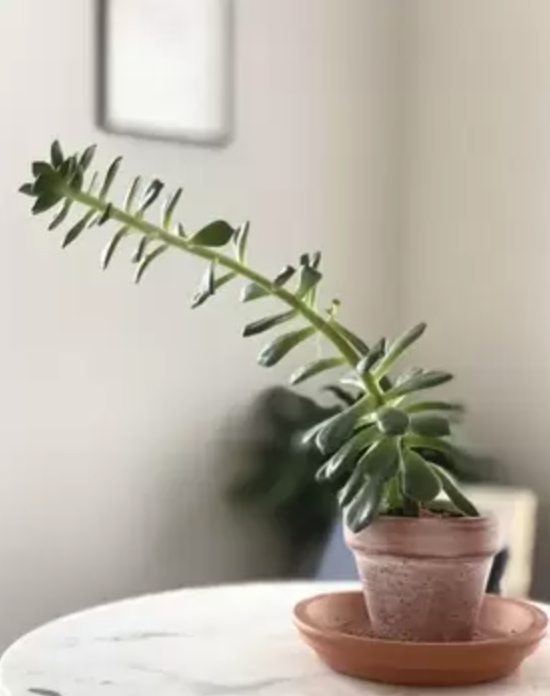Why Your Succulents Keep Dying...
THESE FLESHY FRIENDS ARE BOTANICAL GEMS
Succulents are typically thick and fleshy plants that store water in their leaves and/or stems. Although they come in many colours, shapes and sizes, and depending on their variety, can even survive outdoors through Southern Ontario winters, they are unmistakable -- and adorable!
In recent years, exotic-looking indoor succulents (especially naturally colourful echeveria varieties like those shown above) have become very popular to gift, accent home decor and event incorporate into wedding and event floral designs. Because of their popularity and their ease in propagation, there are now many Southern Ontario greenhouses that grow these botanical gems which means a few positive things:
They are no longer exclusively needing to be flown out of international farms and thus responsible for burning unnecessary fossil fuels;
Their sales are directly supporting local farms, families, the economy and the greater flower farming community;
Their prices have DROPPED!
The price drop is a really good thing because for the newbie plant parent, succulents are notoriously difficult to keep alive, so they get replaced often!
What Sucks about Succulents
Ironically, these guys are so low maintenance that they often revolt against the higher standards of care we allot for other plants. When someone says they can't keep a succulent alive I ask: "have you loved it too much?" 'Too much love', in this case, usually means:
1) Expensive soil
2) Excessive water
3) Exposure shyness
Let's see if one, or a combination, of these are what's killing your crassulaceae friends!
Plant Parenting 101
Wrong Soil = Root Rot
Since succulents are native to arid and semi-desert regions like Central America, Mexico and northwestern South America, they hate moist soil. They're classified as a stonecrop for a reason, so whether you're planting them in the garden or a terrarium, well draining soil is the key.
Often plant parents think that when "potting up" (meaning repotting the plant into a larger vessel to promote growth) rich, nutrient and moisture retaining soil is the recipe for a happy healthy plant. But in the case of succulents, it's not. Succulents are happiest in a soil that allows for easy drainage. I.e. a potting mix blend made specifically for succulents and cacti, which is easy to buy from a local garden centre, plant shop or Amazon. I like to be thrifty, however, so you can DIY the medium by blending:
3 parts potting soil
3 parts coarse sand
1 part perlite
Cause-of-Death: Excessive Drinking
Likely the most common cause of succulent death is overwatering. Plant parents should only water when the soil is bone dry, and the leaves are beginning to lose their turgidness. Overwatering will cause their leaves to turn yellow or brown, then fall off as the whole thing goes to mush like the Wicked Witch of the West (although less audibly).
Unfortunately there's no set schedule for watering your succulents. Outdoors, you're sort of at the mercy of Mother Nature, so provided you've got those Hen and Chicks jammed into a sunny rock face and away from super soggy spots, you're probably good to just ignore them (although applications of a natural 10-10-10 fertilizer, or soil enhancer, 2-3 times a season is always a good idea).
Indoor watering is a different beast entirely. When you determine it's time to water, the simplest way is to place your jardiniere (AKA pot with a drainage hole) on a saucer of shallow water, and wait until the water is absorbed into the soil. Important: Do not allow the pot to sit long in standing water; as soon as the top layer of soil darkens, remove the planter from the saucer. If you're fleshy friend is not potted in a jardiniere, but instead is in a terrarium or vessel without drainage, water it by using a spray bottle and mist the leaves and top layer of soil.
Seek Sunshine
Whether you're succulents are enjoyed indoors or out, sunshine is a must. Most varieties need at least 6 hours a day to maintain their saturated colouring and prevent them from going "leggy".
What does leggy mean? Most common in indoor plants, it's what happens when your plant struggles to find sufficient natural light and stretches itself in that direction. To avoid this odd growth habit, move your pot into a south-facing window during the fall and winter, and then settle them outside with access to natural rainwater for morning exposure (East) during the spring and summer!
Caring for these juicy gems is misleadingly simple, so don't helicopter plant parent. You will find the balance soon enough and if you kill a few of them along the way, don't stress... just buy another one!
Happy plant parenting!





